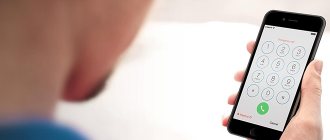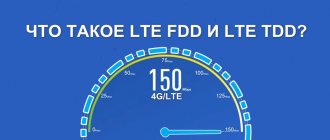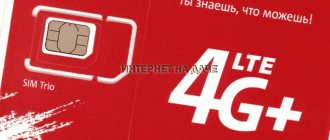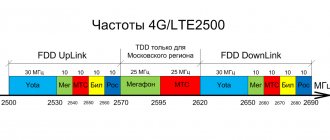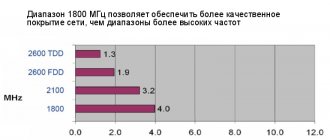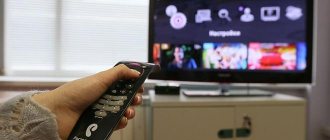Where to find Beeline 4G LTE base stations
Information about the coverage area in graphical form is published on the official website of the mobile operator. For the convenience of users, they are located on an interactive map. You can search by address by zooming accordingly.
The 4G network is displayed in brick color - Moscow, according to Beeline, network distribution in the metro is 100%.
There are no marks indicating the exact location of the base stations. This data is a trade secret. Approximate coordinates can be found using a special service that generates a selection from the general database of the maximum number of registered subscribers.
To receive information, you must indicate the following codes in the request form on the website:
- user mobile device;
- terrain;
- countries;
- cellular operator networks.
A similar search can be done automatically using NetMontor or another application.
How the band system works
Bands are specifications for 4G frequency bands. There are a total of 70 bands covering 4g LTE frequencies from 450 to 2600 MHz, but only 5 are used in Russia:
- B3 (1800 MHz FDD);
- B7 (2600 MHz FDD);
- B20 (800 MHz FDD);
- B31 (450 MHz FDD);
- B38 (2600 MHz TDD).
FDD (Frequency Division Duplex) and TDD (Time Division Duplex) are methods for organizing bidirectional data transmission in the LTE network. FDD is a frequency division of traffic: incoming traffic goes on one frequency, outgoing traffic on another. When using TDD, loading and unloading occur at the same frequency alternately.
From the point of view of mobile operators, TDD technology is more profitable because it allows the use of equipment that supports only one frequency band. FDD is more convenient for the user, since data transmission channels will not interfere with each other and the speed should be higher, especially with a weak signal. But in practice, the difference between FDD and TDD is almost invisible.
Since the data transmission speed in the LTE network depends not only on the frequency, but also on the distance to the base station, the number of communication channels and their width, LTE Advanced technology was developed, which allows the use of several frequency ranges simultaneously. This is called frequency aggregation.
The download speed was raised to 1 Gbit/s, while when using one frequency range it does not exceed 150 Mbit/s. The 4G+ standard places special requirements on the network equipment of the base station and mobile device: they must have the required number of physical antennas (MIMO, Multiple Input Multiple Output). Yota was the first to launch this technology in October 2012, but only a few years later it found widespread use, since at that time modems supporting LTE-A were not on sale.
Most operators divide frequency ranges into incoming and outgoing channels unevenly: for example, Yota and Megafon (this is the same holding) have 40 MHz available throughout Russia in several bands. Of these, 30 MHz is used for downloading and only 10 for uploading. MTS and Beeline use 5 MHz for outgoing traffic in each frequency range, 15 for incoming traffic, so the upload speed is lower than the download speed.
The uniqueness of 4G is that a virtually unlimited number of frequency bands can be used. Due to the high congestion of frequencies from 800 to 2600 MHz, in addition to existing bands, LTE-Unlicensed technology was developed, which allows operation at frequencies above 5 GHz, which do not require licensing from government agencies and are characterized by a low amount of interference. However, no operator has yet used it due to the lack of availability of the corresponding equipment.
What is LTE 1800 and LTE 2600
LTE 2600 is the most popular 4G communication standard in the world. It is used mainly in large cities, since radio waves of this frequency have a relatively low penetrating power and require a large number of base stations, but provide high data transfer rates.
Most of the legacy 2G and 3G networks operate at 1800 MHz, so operators are forced to use it due to lack of channel width at other frequencies. Accordingly, the wider the LTE 1800 channel, the less is left for 2G and 3G. But coupled with the aggregation of 800 MHz and 2600 MHz channels, this makes it possible to achieve a network throughput of 300 Mbit/s even at long distances from the base station.
List of 4G frequencies for Beeline
The range allocated for the operation of mobile networks is divided into groups according to frequency in MHz. Band (channel number) is the code designation of the corresponding band. Short waves (more than 1800 MHz) are used to speed up data transmission and provide good penetration through building walls. This feature is necessary for organizing productive work on the Internet. The use of long (less than 850 MHz) waves helps to increase the communication range in open space.
The table shows Beeline ranges:
| Band | Band, MHz | Technology |
| 7 | 2550-2560 | FDD |
| 2670-2680 | ||
| 20 | 813,5-821 | FDD |
| 854,5-862 |
The abbreviation FDD stands for frequency division of a signal, which allows outgoing and incoming traffic to pass simultaneously. This mode works more stable compared to the temporary (TDD) option.
Frequency ranges of Russian cellular operators.
Frequency ranges are divided into technical and subscriber ranges. For technical bands, frequencies of 5-80 GHz are allocated. Subscriber bands are in the frequencies 790-2700 MHz.
Basic standards for mobile data transmission:
- 2G - GSM-900/1800
- 3G - UMTS
- 4G - LTE
- 5G
Also, intermediate technologies are used at these frequencies:
- 2.5G - GPRS
- 2.75G - EDGE
- 3.5G – HDSPA
The same rules apply to all of the above frequencies:
- The lower the frequency, the larger its propagation zone from the operator’s tower.
- As frequency increases, penetration ability increases (passing through walls and avoiding obstacles).
- As the frequency increases, the throughput (data transfer rate) increases.
How to check if LTE is connected
To search for information, open the thematic section “Network mode” in the “Settings” menu.
Checking the LTE connection - when you enter the number, a menu with data opens immediately on the smartphone screen.
In certain versions of the Android shell, the user can set the preferred option:
- LTE;
- GSM;
- WSDMA.
By fixing the mode, channel switching is eliminated to stabilize communication in difficult conditions.
You can clarify the data using the engineering menu using the following algorithm (example of actions with a Samsung smartphone):
- turn off the Wi-Fi connection in the “curtain” or in “Settings”;
- indicate the network mode “LTE only”;
- dial the code *#0011#.
In the window that opens, the frequency band value is indicated in the Frequency position.
Additional information on the screen helps you evaluate the quality of the connection. At low signal strength (worse than 120 dB), the stability of the connection is disrupted. Similar disadvantages appear if the noise level exceeds the amplitude of the useful signal (CINR<0).
Mobile applications for checking used frequencies
Specialized software, in addition to a convenient interface, provides the user with extensive help information. For example, we can take a closer look at the popular Android application CellMapper.
The following options are available when working with this tool:
- displaying a map of the location of base stations, frequency and other signal parameters;
- support for LTE, GSM and UMTS modes;
- editing and recording of individual data.
In the application, all useful tabs are highlighted in a separate drop-down menu.
Operations can be performed without an Internet connection, but with the GPS module activated; the collected data is subsequently uploaded to the server to create a correct coverage map.
The application operates on any of the 2 SIM cards after registration on the developer’s website.
During the installation process, you must give several permissions to ensure that you receive the following information:
- CellID;
- Cellular network information;
- Samsung Field Test Mode.
The following functions are available:
- writing a CSV file when the Internet connection is disconnected;
- start on boot;
- connection to the duty server;
- obtaining location using GPS signals;
- downloading information for a card from a common database.
On some mobile devices, the application works correctly only if you have root rights. Additional information about CellMapper is published in the Google Play store and on the developer's website.
What does Yota say?
The federal mobile operator Yota announced the start of providing LTE 1800 service to customers.
By combining LTE 1800 and LTE 2600, network capacity has increased and signal propagation and penetration have improved. Since the launch of LTE 1800, network coverage has improved significantly in Moscow, St. Petersburg, the Moscow and Leningrad regions. In addition, the changes affected the Saratov, Amur, Ryazan, Vladimir and Kursk regions, as well as the Republic of Dagestan and other constituent entities of the Russian Federation. “The combined use of LTE 1800 and 2600 has made the network more powerful. If previously the signal inside some buildings, as well as in remote areas, was weak, now our users have access to better network coverage. This became possible due to the fact that LTE-1800 provides a good and stable signal indoors, as well as improved capacity and data transfer speed,” says Yota CIO Andrey Bogdanov.
At the moment, in Moscow and the Moscow region, more than half of the devices registered in the Yota network support LTE 1800. The development of 4G in the 1800 MHz band was made possible thanks to the use by the Yota mobile operator of the combined network of MegaFon PJSC and Scartel LLC.
How to check the signal on a PC
The necessary information can be found using a laptop or PC by connecting a GSM modem to the USB port.
Algorithm of actions when working with a specialized MDMA program:
- before the first start, close the modem service applications;
- in the main menu select the Band Configuration item;
- mark the Custom position and band (Band 7 or 20);
- click OK.
The communication channel parameters are automatically displayed in the window that opens.
What is LTE 1800 and LTE 2600?
LTE networks in different countries operate at different frequencies, and most often several bands are used within a country. In Russia and Europe, most often these are band 3 (LTE 1800), band 7 (LTE 2600), band 20 and band 38. The difference between them is not only in the name and frequency, the “band” used is one of the factors determining the data transfer speed . For example, in the case of Band 3, for a 10 MHz channel, the data transfer rate will be 75 Mbit/s, and the maximum channel width of 40 MHz in the frequency range of 2600 MHz (Band 7) will provide up to 300 Mbit/s. In addition, LTE-Advanced technology implies the ability to combine frequency ranges to speed up data transfer. In this case, the speeds of Band 3 and Band 7 are summed up.


